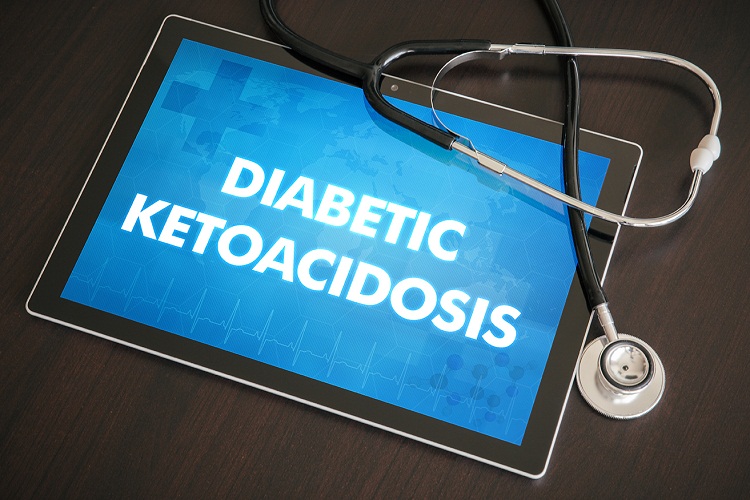Diabetic ketoacidosis is a serious diabetes complication that can lead to hospitalization and can even be life-threatening. It is more prevalent in type 1 diabetes than in type 2. It is a medical emergency that can occur among children, adolescents, and adults with type 1 diabetes. Lack of knowledge and understanding on this condition is one of the main causes for hospitalization.
What is Diabetic ketoacidosis (DKA)?
Diabetic ketoacidosis (DKA) is a metabolic complication of diabetes that is characterized by lack of insulin and high blood sugar levels (hyperglycemia). It is also characterized by the presence of ketones in the urine (ketonuria) and ketonemia (high presence of ketones in blood).
DKA occurs when the levels of insulin drop less than the amounts required to carry normal body functions and metabolism. This deficiency of insulin might occur due to wrong dosage of insulin, and improper administration of insulin therapy in people with type 1 diabetes. There are other causes that can trigger DKA (discusses below).
What are the symptoms of diabetic ketoacidosis (DKA)?
- Nausea
- Vomiting
- Rapid breathing or gasping for breath
- Excessive thirst
- Fruity-smelling breath (like nail polish remover or rotten fruit)
- Frequent urination
- Pain in the abdomen
- Fatigue and weakness
- Confusion
What are the signs of diabetic ketoacidosis?
- High blood sugar levels (hyperglycemia)
- Ketonuria (presence of ketones in urine)
- Ketonemia (high presence of ketones in blood)
- Hypotension
- Tachycardia (high heart rate)
- High pH level of arterial blood
How is DKA caused?
Diabetic ketoacidosis is caused by an illness or an infectionthat makes the body produce high levels of cortisol or adrenaline. These hormones negate the effect of insulin in the body and eventually trigger DKA.
In other cases, inadequate insulin or missed insulin treatments can drastically reduce the levels of insulin in the body making it prone to develop DKA.
Other possible triggers of DKA include:
- Urinary tract infection
- Sepsis
- Pneumonia
- Heart attack
- Stroke
- Pancreatitis
- Trauma
- Usage of medications like corticosteroids, diuretics & SGLT-2 inhibitors
- Substance abuse
In certain unique cases like pilgrimages, especially Amarnath yatra, it is reported that there are certain cases of DKA that seem to arise due to high altitude, excessive physical strain, starvation, and not taking their diabetes medications properly.
How is diabetic ketoacidosis diagnosed?
Diagnosis of DKA is generally done by certain tests that include:
- Blood sugar test (random blood glucose test). For people with DKA, blood sugar level is higher than 250 mg/dL.
- Blood acidity tested by Arterial pH
- Ketones in the blood tested by blood tests
- Urinalysis for ketones
- Serum Creatinine
- BUN
- Osmolarity
- Level of consciousness
- Kidney function test
- Serum electrolytes test
Once the diagnosis of DKA is made, treatment often involves:
- Arresting volume depletion: This is done with replenishment via IV infusion
- Stabilizing and correcting high blood sugar levels via insulin administration
- Correction of acidosis
- Prevention of Hypokalemia (low potassium levels)
How to prevent DKA?
Since DKA occurs due to other major illnesses, and involves complications like cerebral edema, it is very important to identify and prevent this condition to avoid fatal consequences. Moreover, since children with type 1 diabetes are prone to this condition, identifying the symptoms of diabetic ketoacidosis is very important for better outcomes.
In people with type 1 diabetes, diabetic ketoacidosis is caused mainly due to the presence of infections and in general, having poor compliance towards diabetes treatment. Improper insulin therapy, missing out on dosages, poor administration of the insulin injection, and poor diabetes control are huge contributors.
So, it is important for people with type 1 diabetes to:
- Maintain target HbA1c
- Frequently check blood sugar levels with a glucometer
- Follow a diabetes diet plan
- Talk to your diabetes doctor or your endocrinologist on the need for insulin dosage adjustments during infections, fevers, and with varying diet and physical activities
- Work along with a care team for sick-day management. Work with your diabetes doctor, dietician, and your diabetes educator regularly
- Consume easily digestible foods during sick days
- For those trying to prevent recurrence, try home monitoring of ketones
- Get periodical diagnostic tests for various diabetes complications along with a test for ketones
- In case of babies, and small children, it is advisable to follow blood glucose monitoring regimen as per the diabetologists’ recommendation and watch out for early symptoms like vomiting, excessive urine, frequent thirst, dehydration, and altered consciousness.
- Usually, children with type 1 diabetes that go into diabetic ketoacidosis present with vomiting and difficulty breathing. It is important to rush them to a hospital in such cases
Adhering strictly to the diabetes treatment plan and having a sick-day management strategy can avoid diabetic ketoacidosis. However, adolescents, children and in many cases even adults have issues complying with their treatment regimen. This can increase the risk of DKA.
For compliance issues, it is advisable to take a team approach to manage type-1 diabetes. This involves active participation of family members, dietitians, and diabetes educators. Consulting an endocrinologist periodically helps in improving blood sugar control. Apart from this, precautions to avoid any flaws in dosage of insulin administration:
- Make sure the insulin you are using is not expired
- Do not use insulin if it has clumps
- Make sure insulin is either cloudy with small flecks or all clear
- Check closely for any leaks if you use an insulin pump
Check your pump for any air bubbles.











